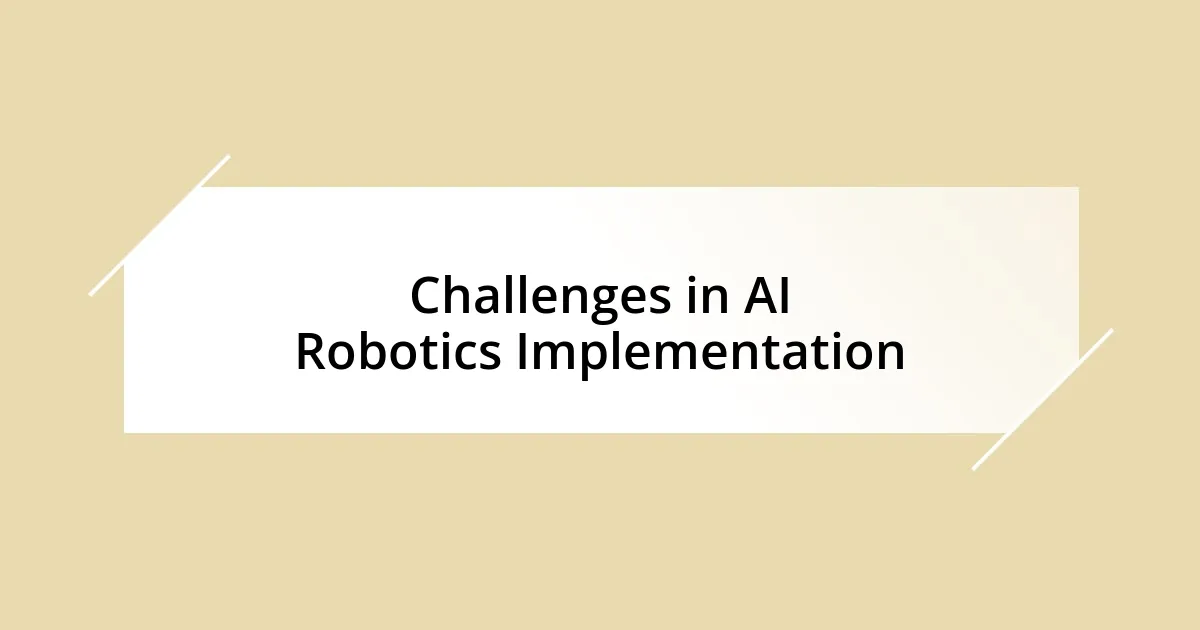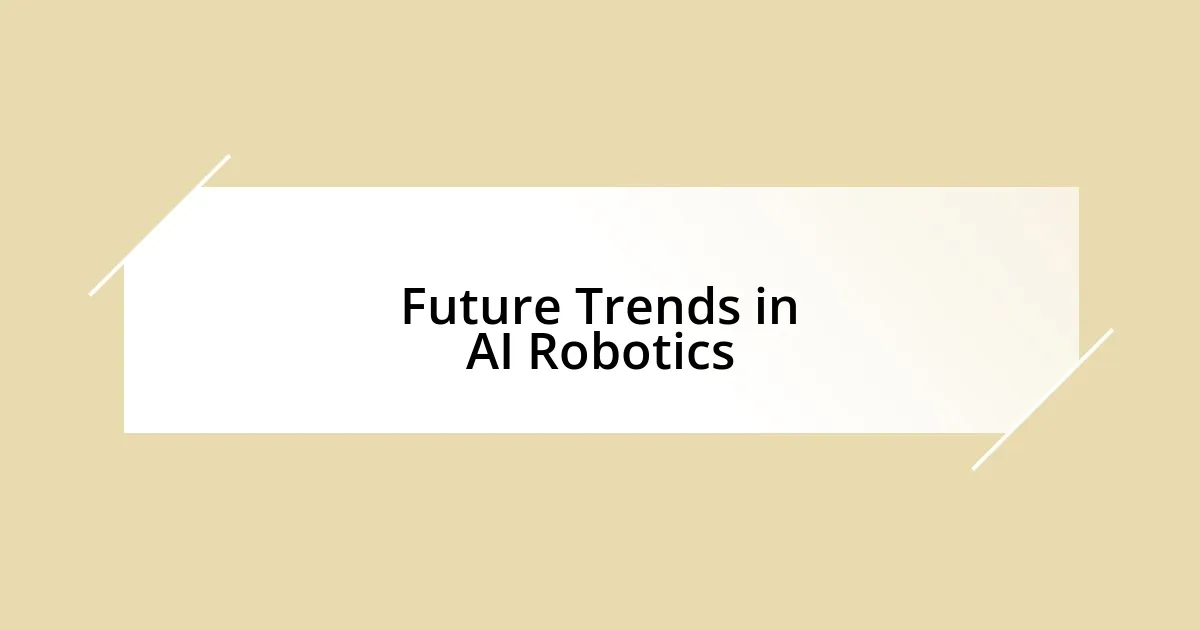Key takeaways:
- AI in robotics enhances machine learning and adaptability, allowing robots to perform complex tasks and improve efficiency across various industries.
- The integration of AI faces challenges such as technical complexity, high costs, limited data, and ethical concerns regarding accountability and bias.
- Real-world applications of AI robotics span healthcare, logistics, and manufacturing, demonstrating transformative potential in enhancing precision and productivity.
- Future trends include collaborative robots with emotional intelligence and a focus on sustainability, aiming to address social and environmental challenges.

Understanding AI in Robotics
When I first encountered AI in robotics, I was amazed by how machines could learn from their environment. This capability transforms simple robotic tasks into complex operations that mimic human thought processes. It’s fascinating to think about how AI algorithms allow robots to adapt and improve—do you realize how revolutionary that is?
On a recent visit to a tech expo, I watched a robotic arm precisely assemble intricate components. It struck me how the arm utilized AI to refine its movements after each task. Can you imagine the potential of such technology in various industries, from manufacturing to healthcare? The insights drawn from these experiences highlight the profound impact of AI-driven robotics.
Understanding AI in robotics isn’t just about programming machines; it’s about enhancing their ability to think and respond in real-time. This leads me to wonder—how far can we push the boundaries of what robots can achieve? As I ponder this, I’m filled with excitement at the possibilities, yet a hint of concern about how society will adapt to these intelligent machines.

Benefits of AI in Robotics
The integration of AI into robotics offers remarkable benefits, one of which is increased efficiency. I recall a time when I observed a warehouse stocked with goods being managed by autonomous robots. With AI, these robots efficiently navigated the space, optimizing their routes in real-time. This not only sped up the order fulfillment process but also significantly reduced human error—such transformational improvements are hard to ignore.
Moreover, AI-powered robots can perform tasks that are dangerous for humans. During a volunteer event on a construction site, I saw how robotic drones mapped hazardous areas, ensuring safety while collecting crucial data. It was incredible to witness machines taking on the risk that humans typically face; this capability isn’t just impressive; it’s life-saving, which evokes a lot of hope for future work environments.
Lastly, there’s the aspect of adaptability. AI allows robots to learn from their environment, adjusting their behavior to meet specific needs. I think about my experience with agricultural robots, which learn to identify and treat crop diseases autonomously. It’s inspiring to see technology not only enhancing productivity but also contributing to sustainable practices in various sectors.
| Benefit | Description |
|---|---|
| Efficiency | AI helps robots optimize tasks and processes, significantly reducing time and errors. |
| Safety | Robots equipped with AI can perform dangerous jobs, ensuring human safety in hazardous environments. |
| Adaptability | AI enables robots to learn and adjust to their surroundings, making them more effective in dynamic scenarios. |

Challenges in AI Robotics Implementation
While the advancements in AI robotics are thrilling, the journey of implementing these technologies comes with a myriad of challenges. I vividly recall a workshop I attended where developers shared their struggles with integrating AI into existing robotic systems. The complexity of aligning AI algorithms with hardware can create significant hiccups—it’s not just about coding; it’s about ensuring that the physical and digital components harmonize.
-
Technical Complexity: The integration of AI systems into robots requires a deep understanding of both hardware and software, which can be overwhelming for teams not equipped with the right skill sets.
-
High Costs: The financial investment needed for developing and deploying AI-driven robotics can be daunting, often putting these resources out of reach for smaller companies.
-
Limited Data: AI relies heavily on quality data for learning and improvement. In scenarios where data is sparse or unrepresentative, AI performance can suffer.
-
Safety Concerns: As robots take on more autonomous functions, ensuring safety protocols are in place becomes critical, particularly in environments shared with humans.
-
Ethical Implications: The introduction of intelligent robots raises ethical questions, like accountability for decisions made by AI—this adds another layer of complexity that companies must navigate.
In another instance, I remember listening to a panel of experts discussing the unpredictability of AI behavior. It’s a double-edged sword; while robots can learn and adapt, sometimes they can misinterpret data, leading to unforeseen consequences. The emotional weight of witnessing a robot err during a demo left many of us with a mixture of fascination and concern. What if an autonomous vehicle misjudges a pedestrian’s movement? It’s these unpredictable elements that give me pause, reminding us that the road to smoother AI robotics implementation is still filled with bumps.

Real World Applications of AI
Real-world applications of AI in robotics span across various sectors, revealing just how transformative this technology can be. Take, for instance, the healthcare industry—I’ve seen firsthand how AI-driven robotic surgery systems can enhance precision during complex procedures. It was remarkable to witness a surgeon guiding a robotic arm through intricate maneuvers with unparalleled accuracy, minimizing risks for patients. This got me thinking: how many lives could we save if more hospitals adopted these sophisticated solutions?
In logistics and delivery, AI is revolutionizing how we receive goods. I remember watching a documentary about autonomous delivery robots buzzing around urban neighborhoods, threading through pedestrian traffic with ease. These little machines not only streamline operations but also have the potential to reduce our carbon footprint. It left me curious—could widespread adoption of such technologies lead to a significant decrease in delivery-related traffic congestion?
Furthermore, AI applications in manufacturing have stepped up productivity levels dramatically. During a factory visit, I marveled at an assembly line where AI-powered robots were collaborating seamlessly with human workers. They adjusted their pace and tasks based on real-time data from surrounding conditions. I couldn’t help but wonder: as AI continues to evolve, could we witness a future where robots not only work alongside us but also enhance our human capabilities?

Future Trends in AI Robotics
The future of AI in robotics is undeniably fascinating, with trends pointing toward increasingly sophisticated capabilities. I recently stumbled upon an event showcasing the next generation of collaborative robots—what we call “cobots.” It was exhilarating to see these robots work side by side with humans, adapting their tasks in real-time based on human input and environmental changes. I couldn’t help but wonder: how will these collaborative dynamics reshape our workspaces in the upcoming years?
One of the key trends that excites me is the rise of emotional intelligence in robots. Imagine a care robot programmed not just to assist but to emotionally engage with elderly patients. I recall discussing this concept with a friend who works in elder care, and we both agreed that having a robotic companion that can recognize emotions could profoundly enhance the quality of life for residents. This idea sparks the question: could these emotionally intelligent robots help bridge the gap in human interactions, especially in settings where loneliness is prevalent?
Sustainability is also becoming a critical focus in AI robotics. Just the other day, I read about robots designed to address environmental challenges, such as pollution cleanup or resource monitoring in natural habitats. It made me think of the potential for these robots to be more than just tools; they could act as stewards of our planet. As we face urgent environmental issues, I’m left with the lingering thought: can robotics play a pivotal role in making sustainable practices the norm rather than the exception?

Ethical Considerations in AI Use
One significant ethical consideration in AI use is the potential for bias in decision-making. I remember a case where an AI system used in hiring demonstrated a preference for candidates from particular backgrounds, impacting the diversity of the workforce. This raises the question: how can we ensure that these systems are designed to be fair and equitable for everyone?
Another concern revolves around accountability. I often ponder who is responsible when an AI-driven robot makes a mistake, like injuring someone during operation. Is it the programmer, the company, or the robot itself? This ambiguity in accountability can hinder trust in AI technologies, making it essential for us to establish clear guidelines on this matter.
Privacy also plays a crucial role in the ethical discourse surrounding AI in robotics. During a recent discussion about surveillance drones, I felt uneasy about the balance between security and individual privacy. As we develop more advanced AI systems that can monitor our every move, I can’t help but ask: at what point do we cross the line from safety into invasive intrusion?












